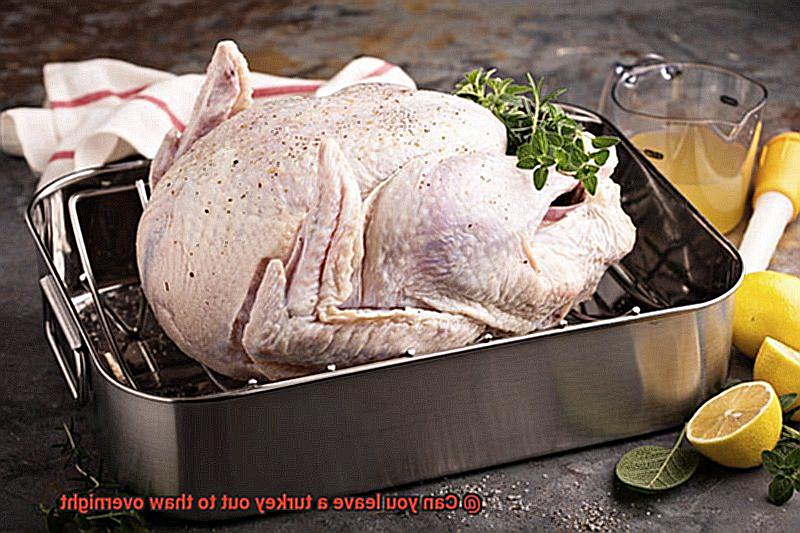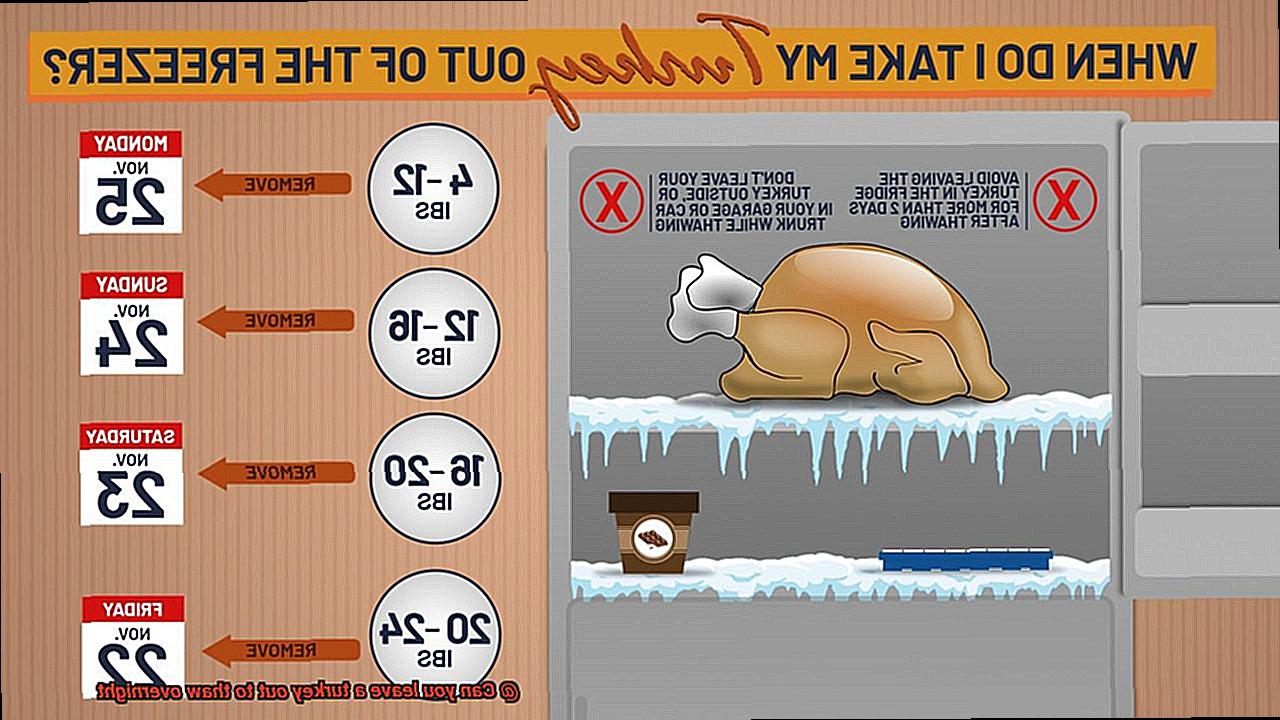Thinking of cooking up a delicious turkey for your next special occasion? Whether it’s a festive Thanksgiving or Christmas feast, there’s nothing quite like the taste of a succulent and juicy turkey. But before you can get started on roasting, you’ll need to defrost the bird first. The question is: can you leave a turkey out to thaw overnight?
If you’re one of those people who always forgets to take the turkey out of the fridge in time, leaving it out on the counter may seem like an easy solution. You’ll save yourself some time and hassle, right? However, is it really safe to do so?
In this blog post, we’ll delve into the topic of thawing turkeys. We’ll explore the risks and benefits of leaving a turkey out overnight compared to other methods such as using the refrigerator or cold water bath. We’ll also identify the ideal temperature and time for defrosting your turkey and give tips on how to tell if it’s still safe to eat.
So if you want to guarantee a successful and secure turkey cooking experience, keep reading. We’ve got all the dos and don’ts for defrosting this mouth-watering bird covered.
Contents
What is the Risk of Leaving a Turkey Out to Thaw Overnight?
Thanksgiving is a time to gather with loved ones and enjoy a delicious feast. As the centerpiece of this feast, the turkey takes center stage, but did you know that the way you defrost your turkey can impact your health? Leaving a turkey out to thaw overnight may seem like an easy option, but it can be a risky practice.
The main risk of leaving a turkey out to thaw overnight is the growth of harmful bacteria. Bacteria thrive in warm and moist environments, which is exactly what a turkey provides when left at room temperature. The most common type of bacteria that can grow on a turkey left out overnight is Salmonella, which can cause severe symptoms such as diarrhea, fever, and abdominal cramps. In some cases, it can even lead to hospitalization.
Another risk of leaving a turkey out to thaw overnight is that it may not thaw evenly. This can make cooking the bird properly more difficult, resulting in an undercooked turkey that can also lead to foodborne illness.
So, what’s the safest way to thaw your turkey? The best method is to thaw it in the refrigerator. This keeps the turkey at a consistent and safe temperature while allowing it to thaw slowly. It’s important to plan ahead as it can take several days for a large turkey to fully thaw. A general rule of thumb is to allow for 24 hours of defrosting time for every 4-5 pounds of turkey.
If you’re short on time and need to defrost your turkey more quickly, you can do so by placing it in cold water. However, this method requires more attention and effort as you need to change the water every 30 minutes and ensure that the turkey stays submerged. Allow approximately 30 minutes per pound of turkey to fully defrost using this method.
Is it Safe to Leave a Turkey Out to Thaw Overnight?
The reason is simple: it’s a breeding ground for harmful bacteria. This can lead to food poisoning, which is definitely not the way you want to spend your Thanksgiving.
Thankfully, the USDA has provided us with three safe methods for thawing turkey, and none of them involve leaving it out on the counter. Here they are:
Refrigerator Thawing
This is the safest method, but it requires the most time. You should allow 24 hours of thawing time in the refrigerator for every four to five pounds of turkey. So, if you have a 20-pound turkey, be sure to give it five days to fully thaw in the fridge.
Cold Water Thawing
If you’re short on time, this method is a great option. Place your turkey in a leak-proof plastic bag and submerge it in cold water. Be sure to change the water every 30 minutes to keep it cold. It takes about 30 minutes of thawing time per pound using this method.
Microwave Thawing
While this can be a quick and convenient option, it’s important to make sure that the manufacturer’s instructions specifically state that it is safe to do so. Follow the instructions carefully and monitor the turkey closely while it thaws.
How Long Should a Turkey be Left Out to Thaw?
Here’s why: when a turkey is left out at room temperature, the outer layer defrosts much quicker than the inside. This creates an environment where bacteria can thrive, potentially leading to foodborne illness.
So, what’s the safest way to defrost your turkey? The USDA recommends three methods: refrigerator thawing, cold water thawing, and microwave thawing (if done carefully). While the refrigerator method is the safest, it requires several days of preparation. If you’re short on time, cold water thawing is another option. Simply place your turkey in a large container of cold water and change out the water every 30 minutes until it’s fully thawed.
It’s important to note that if you choose to use the cold water method, you should plan on cooking your turkey immediately after it’s fully defrosted. This will help ensure that any bacteria that may have started to grow during the thawing process are killed off during cooking.
The Best Way to Thaw a Turkey
Properly thawing a turkey is an essential step, as it helps prevent harmful bacteria growth that can lead to foodborne illnesses. But fear not – I am here to guide you through the best and safest way to thaw a turkey.
First and foremost, it’s crucial to understand that leaving your turkey out on the kitchen counter overnight to thaw is not advisable. This can create an ideal environment for bacteria to thrive, potentially leading to foodborne illness. So, what should you do instead? There are three recommended methods: refrigerator thawing, cold water thawing, or microwave thawing.
Refrigerator thawing is the safest and most highly recommended option. This involves placing your turkey in its original packaging on a tray or pan in the refrigerator. The general rule of thumb is to allow 24 hours of refrigerator thawing time for every 4-5 pounds of turkey. Therefore, if you have a 20-pound turkey, make sure to refrigerate it for at least five days beforehand.
Cold water thawing is another viable option if you don’t have enough time for refrigerator thawing. This method requires placing your turkey in a leak-proof plastic bag and submerging it in cold water, changing the water every 30 minutes. It takes about 30 minutes per pound to thaw a turkey using this method. So, for a 20-pound turkey, you’ll need to change the water every 10 minutes for roughly six hours.
Microwave thawing is the quickest method but requires special attention and can result in uneven thawing. To properly microwave-thaw your turkey, remove all packaging and place it on a microwave-safe dish, following the manufacturer’s instructions for defrosting times. Rotate the turkey every so often and use a meat thermometer to check for any cold spots.
Defrosting in the Refrigerator

The anticipation of a big family dinner can be thrilling, but the thought of defrosting a turkey can be daunting. Enter the refrigerator, the safest and most recommended method for thawing your bird.
To begin, place your frozen turkey on a tray or pan and let it thaw completely in the refrigerator. It’s essential to keep it on the lowest shelf to avoid any drippings from contaminating other food items. The time it takes for your turkey to thaw depends on its weight, so it’s crucial to plan accordingly.
As a general rule of thumb, every 4-5 pounds of turkey requires 24 hours to defrost fully in the fridge. So if you’re cooking a 12-pound turkey, you’ll need to give it at least three days to thaw completely.
One significant advantage of defrosting in the refrigerator is that your turkey stays at a safe temperature throughout the process. The fridge should be set at 40°F or below to prevent harmful bacteria from growing. The slow thawing process also helps preserve the quality and texture of the meat, resulting in a more succulent and flavorful bird.
Once your turkey has thawed entirely in the fridge, it can be kept in there for an additional 1-2 days before cooking. This extra time lets the meat tenderize even further, enhancing its taste and juiciness.
Defrosting in Cold Water
To start, ensure that your turkey is in a leak-proof plastic bag. This step is essential as it will prevent any contamination from the water. Next up, fill a large container or sink with cold water, enough to completely submerge the turkey. Remember, cold water is crucial as warm water can cause bacteria to grow on the surface of the turkey. It’s best to change the water every 30 minutes to keep it fresh and cold.

Now, the million-dollar question: how long does it take to defrost a turkey in cold water? The answer is straightforward – allow 30 minutes of defrosting time per pound of turkey. For instance, if your turkey weighs 12 pounds, it will take approximately six hours to defrost fully in cold water.
But wait, don’t get too comfortable yet. Defrosting a turkey in cold water requires constant attention. You need to check the turkey every hour or so to ensure that it’s entirely submerged and that the water remains cold. Any part of the turkey that’s above the waterline may not defrost correctly.
Once your turkey is fully defrosted, don’t procrastinate – cook it immediately. Refreezing a previously defrosted turkey can increase the risk of foodborne illness.

Tips for Safely Defrosting a Turkey
If you’re planning to cook a turkey for a special occasion, you need to defrost it first. However, defrosting the turkey safely is crucial to avoid the risk of foodborne illnesses. To help you with this, we have compiled some tips for safely defrosting your turkey:
Defrost in the refrigerator
The best and safest way to defrost a turkey is by putting it in the refrigerator. Place the turkey on a tray or pan to catch any juices that may come out as it thaws. Allow enough time for the turkey to defrost fully. Generally, you should plan on 24 hours of defrosting time for every four to five pounds of turkey.
Use the cold water method
If you’re short on time and need to defrost your turkey quickly, you can use the cold water method. Place the turkey in a leak-proof bag and submerge it in cold water. Change the water every 30 minutes, and estimate about 30 minutes of defrosting time per pound of turkey. Remember to cook the turkey immediately after this method.
Don’t leave a turkey out at room temperature
Leaving a turkey out at room temperature for an extended period can allow bacteria to grow and multiply, which can lead to food poisoning. Never leave a turkey out for more than two hours as bacteria can grow rapidly at temperatures between 40°F and 140°F.
Avoid using a microwave
While using a microwave to defrost your turkey might seem like an easy option, it’s not recommended unless your microwave has a defrost function specifically designed for turkeys. Microwaving can result in uneven thawing, which can make some parts of the bird cook faster than others.
Safety first
Always prioritize safety when it comes to defrosting your turkey. By following these tips, you’ll ensure that your turkey is ready to cook safely and deliciously. Remember that the goal is not only to have a delicious meal but also to keep everyone healthy and safe during the process.
T6BTCye-C_E” >
Conclusion
In conclusion, defrosting a turkey is a crucial step in creating a mouth-watering and safe meal for your event. Although leaving it out to thaw overnight may seem like an effortless option, it can put your health at risk due to the growth of harmful bacteria.
To avoid any potential hazards, it’s best to use the refrigerator method. This requires some planning ahead as you’ll need to allow 24 hours of thawing time for every 4-5 pounds of turkey. But trust us; it’s worth the wait.
If you’re running short on time, the cold water method is an excellent alternative. However, you must change the water every half an hour and cook the turkey immediately after defrosting. Microwaving isn’t recommended unless specifically stated by the manufacturer’s instructions.
Always prioritize safety when defrosting your turkey by not leaving it out at room temperature for more than two hours. Bacteria grows rapidly between 40°F and 140°F, so keep your bird submerged in leak-proof plastic bags and check regularly if using the cold water method.
By following these tips and methods, you’ll ensure that your turkey is thoroughly defrosted, safe to eat, and bursting with flavor for your special occasion.






